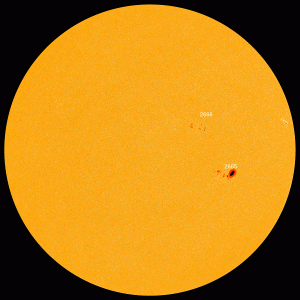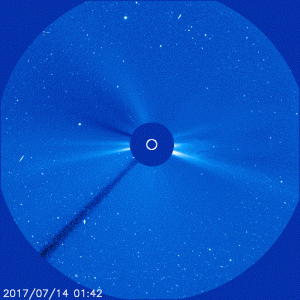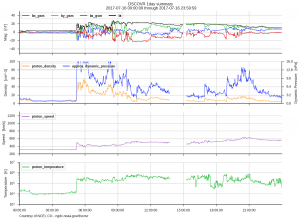
A long-duration M2 (R1-Minor Radio Blackout) class solar flare kicked off a spectacular aurora event that delighted sky watchers across the world. The July 14th event emerged from Sunspot Region 2665. This flare was accompanied by a huge explosion of plasma from the Sun’s corona, better known as a coronal mass ejection (CME). On July 16, the CME made its arrival very early in the morning in the US. Widespread aurora was seen as a result of the CME sparking G2 (moderate) geomagnetic storming. G1 and G2 conditions lasted through out the day on the 16th and into the 17th. Not only did Earth experience a G2 storm but also a S1 (minor) Solar Radiation Storm as a result from the flare. This event provided great examples of space weather activity and storm progression.

This CME erupted while being in Earth’s field of view and resulted in an Earth directed track. NOAA forecasters were able to analyze the CME on the 14th and issued a G2 Geomagnetic Storm Watch for July 16th and 17th with the CME arriving midday on the 16th. While the CME arrived a little earlier than expected, the results of the Space Weather Prediction Center (SWPC) forecast were fairly accurate.
Coronal mass ejections are just one type of space weather phenomena, but can produce significant impacts on Earth. While CMEs can delight sky watchers with brilliant aurora, they can do harm too. Some CMEs are capable of harming power grid operations and can even alter the signal from radio navigation systems that people depend for accurate GPS use.
These huge explosions of plasma originate from highly twisted magnetic field structures on the Sun. When these explosions occur from active sunspot regions on the Sun, it is not uncommon to see them associated with large solar flares. Some fast CMEs can reach the Earth in little as 14 hours, while others may take several days. According to the SWPC, “the first sign of a CME hitting the Earth environment is the plasma density jump due to the shock wave’s passage.” Forecasters use what is known as a coronagraph, which blocks the extremely bright disk of the Sun, so they are able to determine the CME’s size, speed, direction and density.

This storm proved to be a great event for aurora reporters and the citizen science project called Aurorasaurus. This project helps track and map the aurora using twitter and their free mobile app. During the storm aurora reports were rolling in from Canada, North Dakota, Mt. Adams in Washington and even Iowa. Reports also came in from the southern hemisphere in New Zealand where the phenomena is known as aurora australis.
Many citizen scientists submitted reports throughout the early morning hours of July 16; more reports came in on the night of July 17 in Michigan, Wisconsin, and Vermont as this storm came to an end.
For now, the Sun appears to be headed back to relatively quiet conditions with no current sunspots. As the march towards solar minimum continues, coronal holes will likely be the main driver of geomagnetic activity. Unless, of course, an active region like 2665 pops up and sends more CMEs towards Earth.